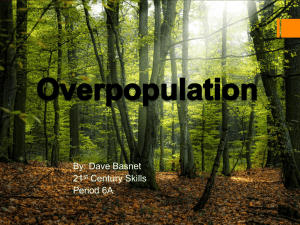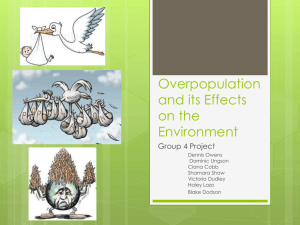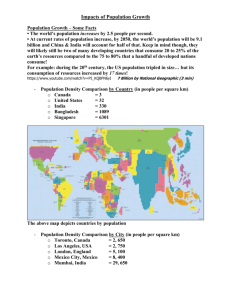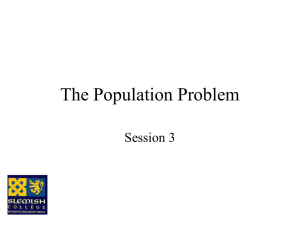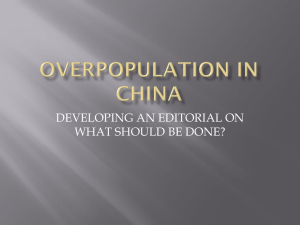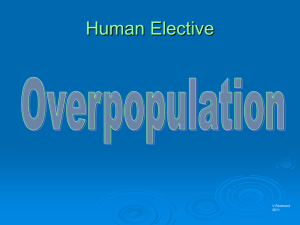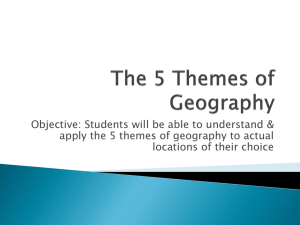Haya Al-Mannai
advertisement
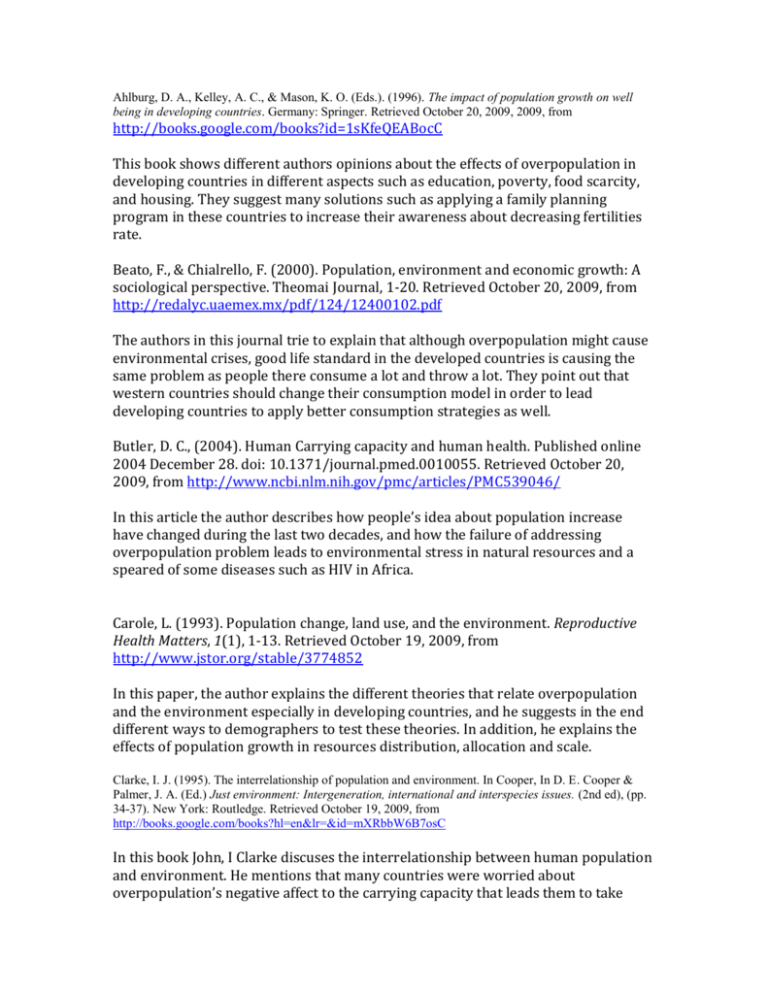
Ahlburg, D. A., Kelley, A. C., & Mason, K. O. (Eds.). (1996). The impact of population growth on well being in developing countries. Germany: Springer. Retrieved October 20, 2009, 2009, from http://books.google.com/books?id=1sKfeQEABocC This book shows different authors opinions about the effects of overpopulation in developing countries in different aspects such as education, poverty, food scarcity, and housing. They suggest many solutions such as applying a family planning program in these countries to increase their awareness about decreasing fertilities rate. Beato, F., & Chialrello, F. (2000). Population, environment and economic growth: A sociological perspective. Theomai Journal, 1-20. Retrieved October 20, 2009, from http://redalyc.uaemex.mx/pdf/124/12400102.pdf The authors in this journal trie to explain that although overpopulation might cause environmental crises, good life standard in the developed countries is causing the same problem as people there consume a lot and throw a lot. They point out that western countries should change their consumption model in order to lead developing countries to apply better consumption strategies as well. Butler, D. C., (2004). Human Carrying capacity and human health. Published online 2004 December 28. doi: 10.1371/journal.pmed.0010055. Retrieved October 20, 2009, from http://www.ncbi.nlm.nih.gov/pmc/articles/PMC539046/ In this article the author describes how people’s idea about population increase have changed during the last two decades, and how the failure of addressing overpopulation problem leads to environmental stress in natural resources and a speared of some diseases such as HIV in Africa. Carole, L. (1993). Population change, land use, and the environment. Reproductive Health Matters, 1(1), 1-13. Retrieved October 19, 2009, from http://www.jstor.org/stable/3774852 In this paper, the author explains the different theories that relate overpopulation and the environment especially in developing countries, and he suggests in the end different ways to demographers to test these theories. In addition, he explains the effects of population growth in resources distribution, allocation and scale. Clarke, I. J. (1995). The interrelationship of population and environment. In Cooper, In D. E. Cooper & Palmer, J. A. (Ed.) Just environment: Intergeneration, international and interspecies issues. (2nd ed), (pp. 34-37). New York: Routledge. Retrieved October 19, 2009, from http://books.google.com/books?hl=en&lr=&id=mXRbbW6B7osC In this book John, I Clarke discuses the interrelationship between human population and environment. He mentions that many countries were worried about overpopulation’s negative affect to the carrying capacity that leads them to take actions forward solving the problem earlier by balancing population number with the resources available. Colombo, B., Demeny, P. G., & Perutz, M. F. (2002). Sources and Population: natural, institutional, and demographic (pp. 254-269). New York: Oxford University. Retrieved October 20, 2009, from http://books.google.com/books?hl=en&lr=&id=qVIQEHcP5toC The author in this book explains how is overpopulation affects in overconsumption as more population need more natural resources such as water, crops, and energy. He suggests countries to focus on educating women about the importance of decreasing population size, as they are the main cause of fertility, and to find solutions for transportation, producing food and fertility. Coward, H. (Ed.). (1995). Population, consumption and the environment: religious and Secular Responses. New York: State University of New York. Retrieved October 20, 2009, from http://www.google.com/books?hl=en&lr=&id=E1q_WxP4jB8C This book contains different religions’ views of overpopulation and how each religion is acting toward solving this issue. The authors view a number of religions’ opinions about overpopulation and their roles toward solving this problem by warning their people about the bad impacts of overpopulation to the environment and natural resources. Graf, C, & Driskell, R. (2009). Population, overpopulation and the impact on the environment. In Dasgupta,S (Eds.), Understanding the global environment (pp. 147160). India: Dorling Kindersley. Retrieved October 19, 2009, from http://books.google.com/books?hl=en&lr=&id=wMiSuQhGJwYC In this book, at chapter 8 the author explains the importance of understanding ecological theories in order to know the relationship between population and environment. He introduces a number of overpopulation negative impacts such as pollution and water scarcity, and he concludes by providing some solutions that might be applied to solve the problem such as improving productivity. Hinrichsen, D., & Robey. (n.d.). Population and the environment: The global challenge. Retrieved October 20, 2009, from http://www.actionbioscience.org/environment/hinrichsen_robey.html? fb_page_id=10001867493& The author in this article explains how is it difficult to protect the environment with a continues population increase, and how the world in this case might face food and water shortage and lose of world species such as forest, coastlines and oceans. He explains also that actions must be taken toward sustaining world population in order to do not face any more of these problems, and to have dynamic economy. Hrivastava, A. K. (2004). Population development environment and health (pp. 1-400). New Delhi: S.B. Nangia. Retrieved November 11, 2009, from http://books.google.com/books?id=jqXsrJTndsYC&printsec=frontcover&hl=ar#v=o nepage&q=&f=false In this book, the author speaks about how population affects in the environment in different aspects like population growth, distribution, education, production, and natural resources. He also suggests ways to stabilize population growth such as increasing women awareness about the importance of decreasing families’ size. John, C. I. (1976). Environment, population, and technology in primitive societies. Population Council, 2(1), 21-36. Retrieved October 19, 2009, from http://www.jstor.org/pss/1971529 The author in this paper explains that the theory that scientist used to use in calculating the rate of population growth in a specific regions that depends on the carrying capacity and food production is wrong. He adds that for the theory to be right, it should include the effects of technological and demographic changes on the area and environment. McMichael, A. J., & Powles, J. W. (1999, October 9). Human numbers, environment, sustainability, and health. Retrieved October 20, 2009, from http://cardiocare.cn/cgi/content/extract/319/7215/977 The author in this article discusses the causes of population increase and its impact to environment and carrying capacity. He describes the changing of population size during the last two decades until today, and how does overpopulation affect in the natural system. He describes also that technology is important in sustaining population increase. However, social development is more important in his opinion. Nerlove, M. (1999). Population and the environment: Parable of firewood and other tales (Vols. 73 - 5, pp. 1334-1347). Blackwell Publishing. Retrieved October 20, 2009, from http://www.jstor.org/stable/1242380 In this book the author focused in the future affects of the relation between population and the environment. He overviewed two different equations, one about how overpopulation affects in the environment, and another about how should human fertility behavior be limited in order to meet environmental sustainability. Paul, S. B. (1969). The impact of human population and natural resources. The Ohio Journal of Science, 69(1), 11-14. Retrieved October 19, 2009, from https://kb.osu.edu/dspace/bitstream/1811/5441/1/V69N01_011.pdf This paper describes that although overpopulation might affects in natural resources, the way of how people and government think might cause the difference. It gives example of how “ Japan, with about 650people per square mile, has efficient agriculture, high literacy rate, full employment, and population control” while” India, with about 500 people per square mile, has none of these advantages.”(P.3) Walsh, S. J., Evans, T. P., Welsh, W. F., Ronald, R. R., & Entwisle, B. (1999). Scale dependent relationships between population and environment in Northeastern Thailand (Vols. 65 - 1, pp. 97-105). American Society for Photogrammetric and Remote Sensi. Retrieved October 20, 2009, from http://www.asprs.org/publications/pers/99journal/january/1999_jan_97-105.pdf In this paper the authors explains the scale dependent of the human population and the resources in Northeastern Thailand, and in which way the population affects the environment. Statistical analyses are used in order to estimate population density in relation with social and biophysical variables.
